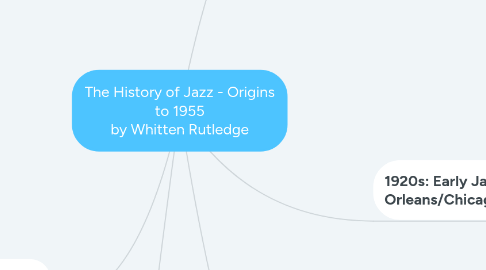The History of Jazz - Origins to 1955 by Whitten Rutledge
by Whitten Rutledge


1. 1940s: Bebop aka Bop
1.1. Nicknamed "Bop," after trumpeter Danny Gillespie's scat-singing, was the newest change in Jazz music. Pioneered by Charlie Parker, Bop changed everything. Musical style more difference in meter and more chromatic in scale. Other Bop artists involve Thelonious Monk, or Kenny Clarke. Here is a video of Charlie Parker's "Donna Lee," 1947.
2. 1950: "Cool School"
2.1. Although the 1950's signaled the beginning of the end for Jazz as a mainstream form of music, there was one last stylistic change. Jazz became more restrained and lower-key Many creative and groundbreaking artists remained, including Duke Ellington and Louis Armstrong. Jazz was still strong and carried on by other names, but declined from the powerful cultural force it once was. Here is a video of a contemporary artist, named Proleter, who makes electronic remixes of jazz music!
3. 1850 to 1900: The Roots of Jazz
3.1. Jazz music began around the turn of the 20th century by black Americans.
3.1.1. Blues
3.1.1.1. Blues began in the second half of the 19th century. It is conventionally a solo-artist improvisation accompanied by a guitar or banjo.
3.1.2. Ragtime
3.1.2.1. Ragtime music was created during the later years of slavery during plantation dances. Although the music was written, it was very free-form.
3.1.3. Brass Bands
3.1.3.1. The early 1850s saw the popularity large bands comprised entirely of brass-instrumented bands. Militaries sometimes made use of them.
4. 1920s: Early Jazz: New Orleans/Chicago
4.1. The 1920s are when Jazz music first went from a simple to a complex form of music. Beginning in New Orleans, it features a simple melody. It is played with brass , such as a trumpet and trombone, alongside piano, drums and strings such as guitar, bass, or banjo. Duke Ellington is considered the most famous jazz musician, but there are other famous jazz musicians such as Fletcher Henderson or Paul Whiteman. Here is a video of Fletcher Henderson's "The Stampede," 1926.
5. 1930s: Birth of Swing Jazz
5.1. During the Great Depression, Jazz began to gain popularity among white Americans. Benny Goodman created a new band when they realized they could sell music for more people to dance to. Black musicians still made jazz in various forms, but swing jazz was largely by and targeted towards white audiences worldwide. Duke Ellington is quoted as saying "Jazz is music, swing is business." Swing is characterized by looser rhythm, a repetitive riff, and less improvisational. Swing jazz gave birth, via the Tommy Dorsey orchestra, to singers like Bing Crosby or Frank Sinatra. Here is a video of Duke Ellington's, "It Don't Mean A Thing," 1932.
5.1.1. Although a traditionally black art form had been co-opted by white people, it lead to segregation that helped black artists find a bigger platform.
